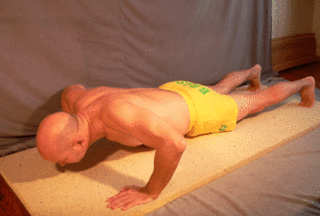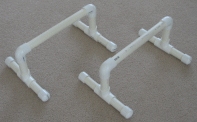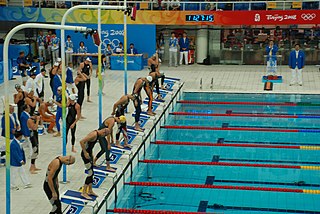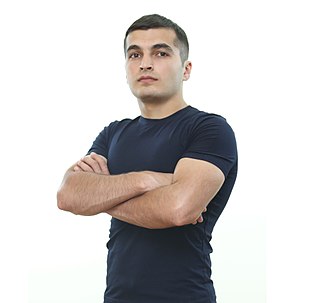Push-up is a calisthenics exercise performed by raising and lowering the body using the arms.
Push-up may also refer to:
Push-up is a calisthenics exercise performed by raising and lowering the body using the arms.
Push-up may also refer to:
Freestyle, or Latin freestyle is a form of electronic dance music that emerged in the New York metropolitan area, Philadelphia, and Miami, primarily among Hispanic Americans and Italian Americans in the 1980s. It experienced its greatest popularity from the late 1980s until the early 1990s. A common theme of freestyle lyricism originated as heartbreak in an urban environment typified by New York City.

Aerobics is a form of physical exercise that combines rhythmic aerobic exercise with stretching and strength training routines with the goal of improving all elements of fitness. It is usually performed to music and may be practiced in a group setting led by an instructor. With the goal of preventing illness and promoting physical fitness, practitioners perform various routines. Formal aerobics classes are divided into different levels of intensity and complexity and will have five components: warm-up, cardiovascular conditioning, muscular strength and conditioning, cool-down and stretching and flexibility. Aerobics classes may allow participants to select their level of participation according to their fitness level. Many gyms offer different types of aerobic classes. Each class is designed for a certain level of experience and taught by a certified instructor with a specialty area related to their particular class.

Calisthenics or callisthenics is a form of strength training that utilizes an individual's body weight as resistance to perform multi-joint, compound movements with little or no equipment.

The pommel horse is an artistic gymnastics apparatus. Traditionally, it is used by only male gymnasts. Originally made of a metal frame with a wooden body and a leather cover, the modern pommel horse has a metal body covered with foam rubber and leather, with plastic handles.

The push-up is a common calisthenics exercise beginning from the prone position. By raising and lowering the body using the arms, push-ups exercise the pectoral muscles, triceps, and anterior deltoids, with ancillary benefits to the rest of the deltoids, serratus anterior, coracobrachialis and the midsection as a whole. Push-ups are a basic exercise used in civilian athletic training or physical education and commonly in military physical training. They are also a common form of punishment used in the military, school sport, and some martial arts disciplines to humiliate and its absence of use for equipment. Variations of push-ups, such as wide-arm push-ups, diamond push-ups target specific muscle groups and provide further challenges.

A handstand is the act of supporting the body in a stable, inverted vertical position by balancing on the hands. In a basic handstand, the body is held straight with arms and legs fully extended, with hands spaced approximately shoulder-width apart and the legs together. There are many variations of handstands, all of which require the performer to possess adequate balance and upper body strength.

"Galvanize" is a song by British electronic music duo The Chemical Brothers featuring vocals by American rapper Q-Tip. It was released on 22 November 2004 as the first single from their fifth studio album, Push the Button (2005).

"Believe" is the second single from English electronic music duo the Chemical Brothers' fifth studio album, Push the Button (2005). The single was released on 2 May 2005 and peaked at number 18 on the UK Singles Chart while reaching the top 20 in Italy and Spain. Kele Okereke, lead singer and rhythm guitarist of the indie rock band Bloc Party is featured on vocals. A remix of the song was featured in the 2005 snowboarding video "Flavor Country" by Sandbox.

Equestrian vaulting, or simply vaulting, is most often described as gymnastics and dance on horseback, which can be practiced both competitively or non-competitively. Vaulting has a history as an equestrian act at circuses, but its origins stretch back at least two-thousand years. It is open to both men and women and is one of ten equestrian disciplines recognized by the International Federation for Equestrian Sports. Therapeutic or interactive vaulting is also used as an activity for children and adults who may have balance, attention, gross motor skill or social deficits.

Parallettes are small gymnastics devices, employed in pairs, used primarily to simulate the parallel bars that can be found in professional gymnasiums. Parallettes are similar to push-up bars or dip bars, but they are generally longer than the former and lower to the ground than the latter.

The handstand push-up (press-up) - also called the vertical push-up (press-up) or the inverted push-up (press-up), also called "commandos" - is a type of push-up exercise where the body is positioned in a handstand. For a true handstand, the exercise is performed free-standing, held in the air. To prepare the strength until one has built adequate balance, the feet are often placed against a wall, held by a partner, or secured in some other way from falling. Handstand pushups require significant strength, as well as balance and control if performed free-standing.
A freestyle skateboarding trick is a trick performed with a skateboard while freestyle skateboarding. Some of these tricks are done in a stationary position, unlike many other skateboarding tricks. The keys to a good freestyle contest run are variety, difficulty, fluidity, and creativity. This is an incomplete list, which includes most notable tricks.

"Push Up" is a single by the British electronic music group Freestylers. The song was co-written by Theo Brehony and Rez Safinia of the pop duo Heist and features vocals from Theo. Released in 2004, it reached number one in the Flanders region of Belgium for seven weeks, number two in Australia and the Netherlands, and number five in New Zealand. In the band's home country, "Push Up" reached number 22 on the UK Singles Chart and topped the UK Dance Chart.
This is a general glossary of the terms used in the sport of gymnastics.

Swimming is an individual or team racing sport that requires the use of one's entire body to move through water. The sport takes place in pools or open water. Competitive swimming is one of the most popular Olympic sports, with varied distance events in butterfly, backstroke, breaststroke, freestyle, and individual medley. In addition to these individual events, four swimmers can take part in either a freestyle or medley relay. A medley relay consists of four swimmers who will each swim a different stroke, ordered as backstroke, breaststroke, butterfly and freestyle.

Manvel Mamoyan is an Armenian fitness and bodybuilding trainer, fitness blogger, and three times Guinness World Records holder. He is also a multiple record holder of Armenian Book of Records (Dyutsaznagirk).

The men's rings competition at the 1936 Summer Olympics was held at the Waldbühne on 10 and 11 August. It was the sixth appearance of the event. There were 111 competitors from 14 nations, with each nation sending a team of up to 8 men. The event was won by Alois Hudec of Czechoslovakia, the nation's first victory after winning two silver medals and two bronze medals in 1924 and 1928. Leon Štukelj was the silver medalist in Berlin, the second man to earn two medals in the rings after his 1928 gold. Host Germany took a bronze medal, its first in the rings since 1896, as Matthias Volz finished third.

The men's parallel bars competition at the 1936 Summer Olympics was held at the Waldbühne on 10 and 11 August. It was the sixth appearance of the event. There were 110 competitors from 14 nations, with each nation sending a team of up to 8 men. The event was won by Konrad Frey of Germany, the nation's first victory in the event since 1896. Germany also took the bronze, as Alfred Schwarzmann finished third. Second place and the silver medal went to Michael Reusch of Switzerland. Germany was the first nation to have two gymnasts win the parallel bars.

The men's horizontal bar competition at the 1936 Summer Olympics was held at the Waldbühne on 10 and 11 August. It was the sixth appearance of the event. There were 110 competitors from 14 nations, with each nation sending a team of up to 8 men. The event was won by Aleksanteri Saarvala of Finland, the nation's first victory in the event. Germany took silver and bronze, as Konrad Frey finished second and Alfred Schwarzmann finished third.